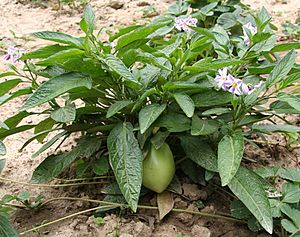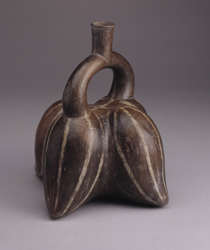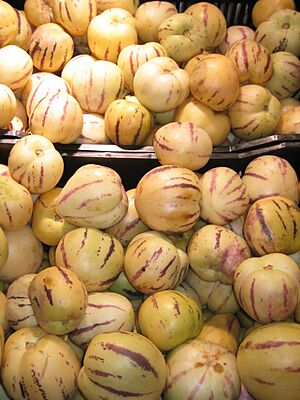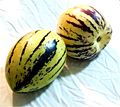Solanum muricatum facts for kids
Quick facts for kids Solanum muricatum |
|
|---|---|
 |
|
| Plant with flowers and ripening fruit | |
| Scientific classification | |
| Genus: |
Solanum
|
| Species: |
muricatum
|
| Synonyms | |
|
|
The pepino dulce (say "peh-PEE-noh DOOL-seh") is a special plant from South America. It's an evergreen shrub, which means it stays green all year round. People grow it because it has a yummy, sweet fruit that you can eat!
Its name, pepino dulce, means "sweet cucumber" in Spanish. This helps people tell it apart from regular cucumbers, which are also called "pepino" in Spanish. Sometimes, people just call it "pepino."
The pepino dulce fruit looks a bit like a melon and tastes like a mix of honeydew melon and cucumber. Because of this, it's also known as "pepino melon" or "melon pear." Even though some call it "tree melon," it doesn't really look like a tree. It's more like a plant that spreads out on the ground.
This plant is a close relative of other well-known plants that grow fruits, like the tomato and the eggplant. Its fruit even looks a lot like a tomato! You can find pepino dulce fruits in markets in countries like Colombia, Kenya, Bolivia, Peru, and Chile. It's not as common in other parts of the world because the fruit is delicate and doesn't travel well.
Contents
Where Pepino Dulce Grows
The pepino dulce likely comes from the cool Andes mountains in Colombia, Peru, and Chile. We don't know exactly where it first grew in the wild. It's a plant that people have grown for a very long time.
How Pepino Dulce is Grown
It's hard to find old pepino dulce fruits in archaeological digs because they are soft and don't preserve well. However, old Spanish explorers wrote about people growing them along the coast. The Moche Valley in Peru was especially famous for these fruits. Ancient Moche art even featured the pepino dulce as a popular design!
In the United States, people were growing pepino dulce in San Diego by 1889 and in Santa Barbara by 1897. Later, new types of pepino dulce were brought from places like New Zealand. This helped the fruit become more popular in fancy markets in Japan, Europe, and North America.
The pepino dulce plant is quite strong. In its home region, it can grow from near sea level up to 3,000 meters (about 10,000 feet) high. It grows best in warm places where it doesn't get too cold. The plant can handle temperatures as low as -2.5 °C (27 to 28 °F) for a short time, but it might lose many of its leaves.
This plant is a perennial, meaning it can live for many years. However, farmers often replant it every year because it can be sensitive to cold, bugs, and diseases. Pepino dulce also grows well in greenhouses. Inside a greenhouse, plants can grow up to 2 meters tall and produce two or three times more fruit than plants grown outdoors.
Planting and Care
Pepino dulce plants are usually grown from cuttings, which are small pieces of the plant. These cuttings grow roots easily without needing special hormones. They are grown much like their relatives, the tomato plants. Pepino dulce plants naturally grow upright like a bush. Sometimes, growers use supports to help hold up the heavy fruit.
The plant grows quickly and starts to produce fruit within 4 to 6 months after being planted. Even though it's a perennial, it's often grown as an annual, meaning it's replanted each year. Young pepino plants don't like weeds around them. But once they are bigger, they can compete well with smaller weeds.
Just like tomatoes and eggplants, pepino dulce plants can attract bugs like beetles, aphids, white flies, and spider mites. These plants can grow in most types of soil. However, they need to be watered regularly to produce a lot of fruit. Older plants can handle some dry spells, but this usually means they won't make as much fruit.
The plants are also "parthenocarpic." This means they can produce fruit even without pollination, though pollination helps them make more fruit.
Where it's Grown Today
Today, pepino dulce is mainly grown in Chile, New Zealand, and Western Australia. In Chile, over 400 hectares (about 1,000 acres) are planted in the Longotoma Valley. More and more of these fruits are being sent to other countries. Colombia, Peru, and Ecuador also grow the plant, but mostly for local use.
Outside of South America, it's grown in parts of Central America, Morocco, Spain, Israel, and the highlands of Kenya. In the United States, some hundreds of acres are grown on a smaller scale in Hawaii and California. Thanks to new types of plants from New Zealand, the fruit is becoming more common in markets around the world.
Culinary Use
Pepino dulce fruits have a delicate and mild flavor. They are often eaten fresh as a snack. They also taste great when mixed with other fruits in salads or smoothies.
Images for kids
See also
 In Spanish: Solanum muricatum para niños
In Spanish: Solanum muricatum para niños








